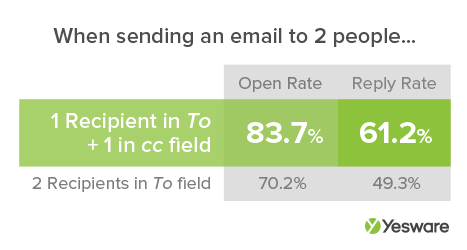Here Are 6 Data-Backed Tricks for Getting Your Sales Emails Opened

This story originally appeared on Salesforce
Your prospect’s inbox is a cutthroat place to be.
With over 100 billion emails sent every day, it’s getting harder and harder to stand out from the other scores of attention-seeking messages your customer deals with each day. Or better yet, get an actual reply to your email.
But it’s far from hopeless. At Yesware, we analyzed more than half a million sales emails sent by our users in Q1 2014 to figure out what can help improve your chance of getting your emails read and replied to. Here’s what we learned:
Related: Stop Using These Words In Your Emails
1. Send emails in the early morning or evening.
People are most responsive to emails they receive early in the morning (between 6 and 7 am) or later in the evening (around 8pm).
Why? It could be because there’s significantly less email being sent during these times. With less to compete with, your email is more likely to stand out and get noticed, leading to better open and reply rates.
2. Treat all weekdays as equal but don’t discount the weekends.
If you’re saving Friday afternoon emails for Monday, you’re doing it wrong. Email open and reply rates are largely the same, no matter what weekday an email is sent.
However, things are much different on the weekend; open and reply rates are significantly higher.
Don’t want to work weekends? Try scheduling your emails so that they arrive on Saturday or Sunday when there is less inbox competition.
3. Focus less on the length of your subject line and more on word choice.
We found that subject line length did not have a significant impact on email open and reply rates.
Certain subject line words, however, did make an impact. For example, emails with subject lines containing “campaign,” “steps,” and “next” had the highest open and reply rates, while emails with the words “online” and “calendar” had the lowest.
Ultimately, the best way to understand what makes some email subject lines more or less effective is to study what works for others and then try it for ourselves. Start your research by checking out the full Yesware subject line analysis data visualization.
Related:The 5 Mistakes That Will Land Your Email in the Spam Folder
4. When emailing two recipients, send to one and copy another.
The data revealed that emails sent to one person (using the To: field) while copying another (using the CC: field), had a higher open and reply rate than messages sent to two people at once (both in the To: field).
Why? We hypothesized that it has something to do with a sociopsychological phenomenon known as the Diffusion of Responsibility:
When a task is placed in front of a group of people, individuals are more likely to assume that someone else will take responsibility for it.
So, no one does.
If your recipients see that multiple people are included in the message, they could assume someone else will take the lead in responding. So play it safe by always designating one person at the main recipient, and copying everyone else that needs to be kept in the loop.
5. If you haven’t heard back in 24 Hours, it’s time to send another email.
The lifespan of an email is incredibly short. If your email is every going to be opened, 91% of the time it’s going to be opened within a day after you sent it. Any replies will also most likely occur that day, so don’t sit around waiting if you haven’t received a response within a day or two.
6. Always follow-up.
Seventy percent of unanswered sales email chains stopped after the first attempt. That’s a lot of missed opportunities.
According to Yesware’s data, if you don’t receive a reply to your first email, you have a 21% chance of getting a reply to the second one. Still no reply? Take heart and keep sending: There’s still a 25% chance that you will eventually hear back from the recipient.

Related: The Best Email You Ever Wrote
How do you plan to integrate these strategies in your upcoming email outreach?
Your prospect’s inbox is a cutthroat place to be.
With over 100 billion emails sent every day, it’s getting harder and harder to stand out from the other scores of attention-seeking messages your customer deals with each day. Or better yet, get an actual reply to your email.
But it’s far from hopeless. At Yesware, we analyzed more than half a million sales emails sent by our users in Q1 2014 to figure out what can help improve your chance of getting your emails read and replied to. Here’s what we learned:






